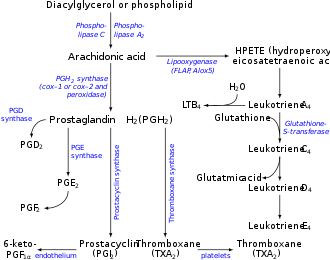Top Qs
Timeline
Chat
Perspective
Prostacyclin synthase
Enzyme found in humans From Wikipedia, the free encyclopedia
Remove ads
Prostaglandin-I synthase (EC 5.3.99.4) also known as prostaglandin I2 (prostacyclin) synthase (PTGIS) or CYP8A1 is an enzyme involved in prostanoid biosynthesis that in humans is encoded by the PTGIS gene.[4] This enzyme belongs to the family of cytochrome P450 isomerases.
Remove ads
Function
This gene encodes a member of the cytochrome P450 superfamily of enzymes. The cytochrome P450 proteins are monooxygenases which catalyze many reactions involved in drug metabolism and synthesis of cholesterol, steroids and other lipids. However, this protein is considered a member of the cytochrome P450 superfamily on the basis of sequence similarity rather than functional similarity. This endoplasmic reticulum membrane protein catalyzes the conversion of prostaglandin H2 to prostacyclin (prostaglandin I2), a potent vasodilator and inhibitor of platelet aggregation. An imbalance of prostacyclin and its physiological antagonist thromboxane A2 contribute to the development of myocardial infarction, stroke, and atherosclerosis.[5]
Unlike most P450 enzymes, PGIS does not require molecular oxygen (O2). Instead it uses its heme cofactor to catalyze the isomerization of prostaglandin H2 to prostacyclin. Prostaglandin H2 is produced by cyclooxygenase in the first committed step of prostaglandin biosynthesis.
Remove ads
Nomenclature
The systematic name of this enzyme class is (5Z,13E)-(15S)-9alpha,11alpha-epidioxy-15-hydroxyprosta-5,13-dienoate 6-isomerase. Other names in common use include prostacyclin synthase, prostacyclin synthetase, prostagladin I2 synthetase, PGI2 synthase, PGIS, PTGIS, and PGI2 synthetase.
Pathways
 |
 |
Molecular interactions
Generally, protein–protein interactions play crucial roles and are critical for formation of protein microenvironment, cell signaling and direct regulation of the activity of metabolic enzymes. Information on tissue-specific spectrum of molecular interactions of prostacyclin synthase will be useful for subnetwork analysis of PTGIS. Following proteins became known as potential direct binders of PTGIS: CYP2J2, GST, GSTA1, GLRX3, AKR1A1. Protein–protein and protein-peptide interactions were experimentally verified using surface plasmon resonance technology.[6]
Remove ads
See also
References
Further reading
External links
Wikiwand - on
Seamless Wikipedia browsing. On steroids.
Remove ads




